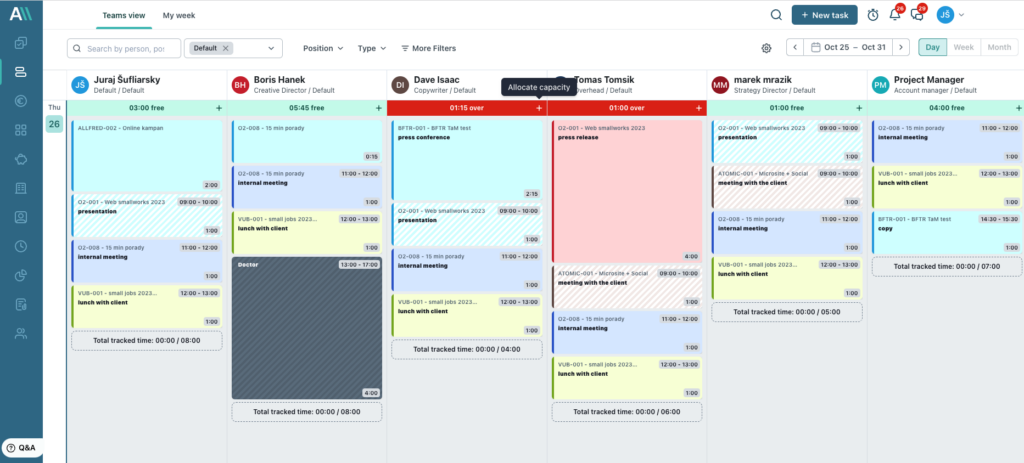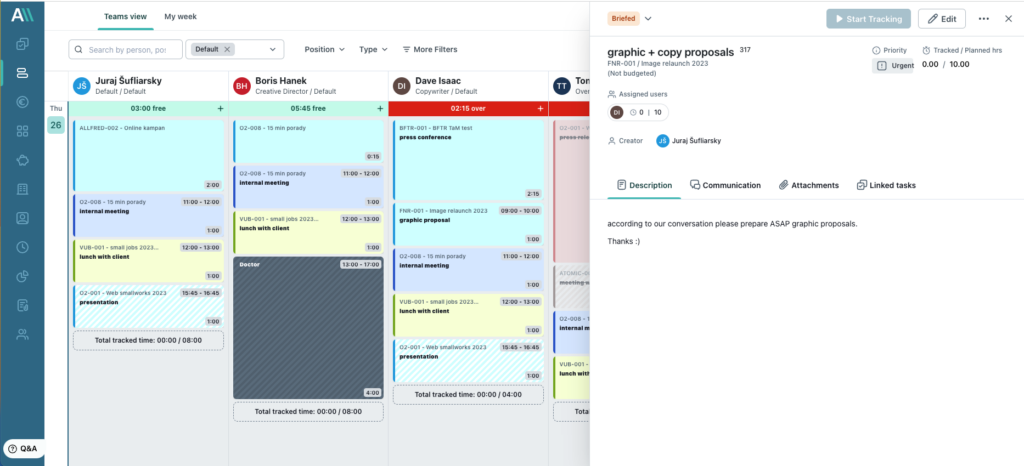In the bustling world of creative agencies, timely project delivery while ensuring a balanced workload is a delicate juggle. With tight deadlines, changing client needs, and dynamic team roles, the importance of effective resource planning cannot be emphasized enough.
Table of Contents
What actually is resource planning?
Capacity planning, in the realm of agency management, is the strategic process of determining the total capacity needed by an agency to meet changing demands for its services. At its core, capacity planning revolves around ensuring that an agency has the right amount of staff with the necessary skills, appropriately allocated, to execute projects efficiently and meet client deadlines.
The very essence of capacity planning becomes evident when confronted with the challenges agencies typically face. Agencies often grapple with evolving client demands, skillset mismatches, overlapping project timelines, and the crucial task of preventing team burnouts. Addressing these challenges head-on is integral to harnessing the full potential of resource planning.
The Pivotal Role of Capacity Planning in Agency Growth and Efficiency
Diving deeper, let’s dissect why capacity planning holds monumental importance for agencies, especially when viewed from the lens of a CEO or managing directors:
1. Foundation for Sustainable Growth
For CEOs looking at the long-term trajectory, effective capacity planning is the linchpin for sustainable growth. It ensures that as the agency scales, its human resources scale in tandem, not just in numbers but in roles and skills, preventing overstretching and underutilization.
2. Profitability and Financial Health
Efficient capacity planning translates directly to financial gains. When resources are allocated judiciously, agencies can avoid the economic drains of idle staff or the risks of turning down projects due to lack of professionals.
3. A Pulse on Agency Health
Capacity planning acts as a barometer, providing CEOs a bird’s eye view of the agency’s operations. It offers insights into work distribution, potential bottlenecks, and areas that need intervention.
4. Maintaining a Competitive Edge
In the world of agency business, the speed and quality of deliverables can be a differentiator. Proper capacity planning ensures that projects don’t lag due to resource mismatches, thereby upholding the agency’s reputation and client trust.
5. Boosting Team Morale and Retention
For CEOs, the well-being of their teams is paramount. Balanced workloads mean teams feel challenged yet not overwhelmed. It can lead to higher job satisfaction, lower burnout rates, and in the bigger picture, enhanced talent retention.
6. Seamless Workflow
A smoothly functioning agency is like a well-oiled machine. With effective capacity planning, inter-departmental coordination improves, leading to seamless workflows and timely project deliveries.
In summation, as CEOs, the perspective on capacity planning goes beyond mere numbers. It’s about orchestrating a symphony where each note is crucial. It’s not just about filling seats; it’s about maximizing every resource in tune with the agency’s vision, growth trajectory, and client commitments. And as we venture further, we’ll explore how to make this symphony pitch-perfect.

7 Steps to Effective Capacity Planning
As we transition from the significance of capacity planning to its practical application, it’s evident that a proactive approach, combined with the right tools and insights, can significantly enhance your agency’s productivity.
Just as a seasoned maestro skillfully directs each musician in an orchestra, team leaders must efficiently coordinate their teams for optimal project delivery. The ability to forecast demand, gauge current capacity, and continually adjust based on real-time feedback are pivotal in this process.
Here, we’ll explore the sequential steps to master the art of capacity planning:
1. Assess and Understand Team Strengths
Before any strategic planning can take place, understanding your team is paramount. Dive deep into the strengths, weaknesses, and unique specialties of each member. This foundational knowledge ensures that tasks align with individual capabilities, maximizing productivity and job satisfaction.
2. Calculate Resource Capacity
Know what your team can handle. Especially when onboarding new clients or starting major projects, it’s vital to assess if your current team has the capacity to handle the additional workload without getting overwhelmed. This step is essential to ensure you’re not overcommitting and risking burnouts.

3. Align Capacity with Demand
An effective capacity planning strategy is responsive to both internal team capabilities and external project demands. By aligning resource capacity with the demands of the project pipeline, agencies can ensure that resources are optimally utilized, and projects are delivered on schedule.
4. Prioritize Tasks
Not every task carries the same weight. It’s essential to have a clear hierarchy of task importance, especially when resources are stretched thin. Defining and adhering to these priorities ensures that mission-critical tasks receive the attention they deserve.
5. Embrace Technology for Real-time Insights
In the modern age of agency operations, leveraging technology is no longer a luxury but a necessity. Platforms like Allfred transcend being mere tools – they’re strategic enablers. The Planning software offers a comprehensive bird’s eye view of the entire agency’s workload, streamlining the process of making data-driven decisions.
Allfred facilitates easy access to task assignments, detailed project insights, and efficient team communication, all in one place.

6. Regularly Review and Adjust
The dynamic nature of agency operations demands flexibility. Constantly reviewing and adjusting resource allocations in response to changing project landscapes ensures that your agency remains agile and effective.
7. Keep a Buffer
Predicting every exigency is impossible. Therefore, always factor in a buffer for unexpected tasks, project scope changes, or unforeseen challenges. This safety net can be the difference between meeting a deadline and missing one.
Capacity planning is a blend of foresight, strategic allocation, and constant calibration. It’s about ensuring that each team member is positioned to deliver their best, without feeling overwhelmed. With these steps and the right tools like Allfred, CEOs and team leaders can craft a finely-tuned agency orchestra that performs harmoniously, even in the most demanding scenarios.
Ready to Transform Your Agency’s Resource Planning?
Navigating capacity planning is pivotal for agency efficiency, growth, and team morale. By understanding team dynamics, setting priorities, and integrating the right tools, agencies can achieve timely project delivery without stressing their teams.
With Allfred leading the charge, data-driven decisions and streamlined operations become your agency’s strengths. This platform acts as a connector between your goals and their achievement.
As we wrap up, consider this: Allfred isn’t just a tool, but a partner in your agency’s journey towards unparalleled growth and efficiency. Embracing its capabilities could be the pivotal move that sets your agency apart. So, are you ready to redefine your agency’s future? The time to act is now.


